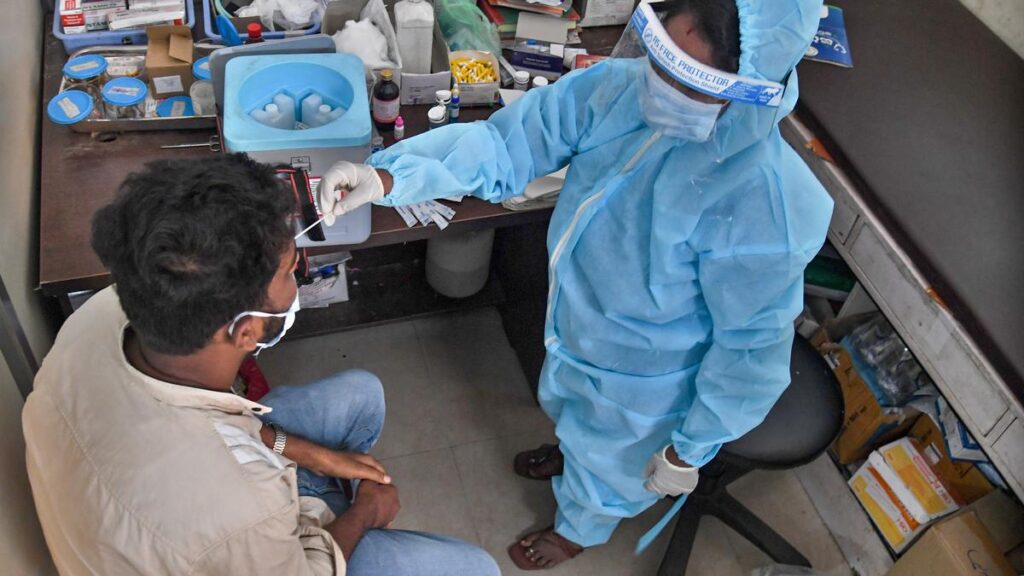
Nearly all the cases in India currently are mild, and do not require hospitalisation, Health Ministry officials have said. Photograph used for representational purposes only
| Photo Credit: DEEPAK KR
The story so far
The Indian government recently confirmed that there has been a surge in the number of COVID-19 cases across Asia over the past few weeks. Stating that India too, has reported 257 cases this year, it said that all States have been alerted about the situation and have been asked to remain vigilant and initiative preventive measures.
Maharashtra, which has reported the maximum surge, saw an uptick in active cases. Cases in the State went up from 12 to 56 in one week. Other states including Kerala and Tamil Nadu have also reported a surge in COVID-19 cases. Other states including Karnataka, Gujarat, Delhi, Haryana, Rajasthan, and Sikkim have reported single-digit infections.
“As per preliminary information available, the cases are mostly mild, not associated with unusual severity or mortality,” Health Ministry officials told The Hindu.

Is the virus active in Southeast Asia?
A significant number of cases have been reported in Hong Kong and Singapore, two of Asia’s biggest cities. According to the Hong Kong’s Center for Health Protection, the virus is quite active. Health authorities in Hong Kong and Singapore, China and Thailand have urged people to take new booster vaccinations.
“While the increase in cases could be due to factors including waning population immunity, there is no indication that the circulating variants are more transmissible – or cause more severe cases – than during the pandemic,” Singapore’s Health Ministry said.
What are the Centre’s directives to States?
According to experts, the JN.1 variant and its related descendants, which belong to the Omicron family, is causing the surge. As per Singapore health authorities, new variants, LF.7 and NB.1.8, descendants of the JN.1 variant, are circulating rapidly.
India’s Health Ministry said recently that it has reviewed the domestic situation to assess risks and said that ‘it remains alert and proactive, ensuring readiness to protect public health as the situation evolves.’
“Nearly all the cases in India currently are mild, and do not require hospitalisation. Hospitals have been advised to closely monitor influenza-like illnesses and severe acute respiratory infections,’’ said a Union Health Ministry official following a high-level meeting chaired by the Director General of Health Services (DGHS) and experts from the National Centre for Disease Control (NCDC), Emergency Medical Relief, Disaster Management Cell, Indian Council of Medical Research (ICMR), and major government hospitals recently.

The official added that as per preliminary reports, cases in India remain mostly mild, without unusual severity or fatalities. “The COVID situation in India continues to be under control,’’ said the Ministry.
It was on 11 March 2020 that World Health Organisation (WHO) declared COVID-19 outbreak a pandemic and reiterated the call for countries to take immediate actions and scale up response to treat, detect and reduce transmission to save people’s lives.
What was the recent Covid deaths controversy about?
Recently, the Central Government also issued a statement about excess COVID-19 deaths during 2020-21 as indicated in the latest Civil Registration System (CRS) data. The new data from the country’s official record of births and deaths indicated that about 21 lakh more deaths were registered in 2021, the year of the deadly Delta wave of Covid-19, compared to 2020.
“All deaths are not equal to COVID-19,’’ said a senior Health Ministry official adding that India’s cumulative excess mortality for 2020-2021 was 9.3 per cent higher than expected deaths, a figure which was lower than that of the U.S., Italy and Russia.
A WHO report had however, estimated India’s excess deaths at 47 lakhs. Another report in a top medical journal cited a figure of about 41 lakh excess deaths in this period.
The source further explained that the increase in deaths registered in CRS could be attributed to several reasons, including a larger population cohort, maturing reporting processes and increased awareness of the need for registration, leading to higher registration levels.
Published – May 23, 2025 01:54 pm IST

